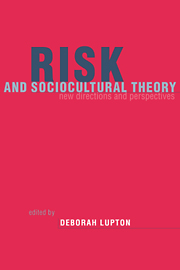Book contents
- Frontmatter
- Contents
- List of contributors
- Introduction: risk and sociocultural theory
- 1 Postmodern reflections on ‘risk’, ‘hazards’ and life choices
- 2 Fear of crime and the media: sociocultural theories of risk
- 3 Risk and the ontology of pregnant embodiment
- 4 Risk anxiety and the social construction of childhood
- 5 Constructing an endangered nation: risk, race and rationality in Australia's native title debate
- 6 Risk, calculable and incalculable
- 7 Ordering risks
- Index
3 - Risk and the ontology of pregnant embodiment
Published online by Cambridge University Press: 16 September 2009
- Frontmatter
- Contents
- List of contributors
- Introduction: risk and sociocultural theory
- 1 Postmodern reflections on ‘risk’, ‘hazards’ and life choices
- 2 Fear of crime and the media: sociocultural theories of risk
- 3 Risk and the ontology of pregnant embodiment
- 4 Risk anxiety and the social construction of childhood
- 5 Constructing an endangered nation: risk, race and rationality in Australia's native title debate
- 6 Risk, calculable and incalculable
- 7 Ordering risks
- Index
Summary
Introduction
In an article in a weekend newspaper supplement, entitled ‘Mother love gone wrong’, Elizabeth Bellamy writes of her experience of what was professionally diagnosed as Obsessive-Compulsive Disorder. She has suffered from this twice in her life – both times when she was pregnant. The disorder first manifested itself when she was five months pregnant with her first child as an extreme worry that something she ate or did would harm her foetus: ‘I came to believe that every familiar object was contaminated in some way – food, crockery, cutlery, clothes, sheets, books, and so on. The world was swarming with harmful bacteria that I couldn't control or eradicate’ (Bellamy, 1998: 16, original emphasis). In the first episode of this state of anxiety, Bellamy was admitted to a psychiatric hospital ward for five weeks. She recovered completely when her baby was born healthy. ‘As I had tried to explain to the doctors, I was only concerned about the health of the baby. I didn't give a damn about me’ (16). After much deliberation, Bellamy and her husband decided to have another child. This time, she dealt with her fears not by attempting to discount them, but by giving in to them. She washed her hands repeatedly and only ate food that she prepared herself. As a result, she was able to cope with her anxieties about the foetus' health and did not require psychiatric treatment. Again, her anxieties and obsessions vanished with the birth of her baby.
This woman's experience is clearly extreme. It was treated by professionals and represented by the woman herself as an individual's psychiatric disorder, a rare pathological response to pregnancy.
- Type
- Chapter
- Information
- Risk and Sociocultural TheoryNew Directions and Perspectives, pp. 59 - 85Publisher: Cambridge University PressPrint publication year: 1999
- 109
- Cited by



